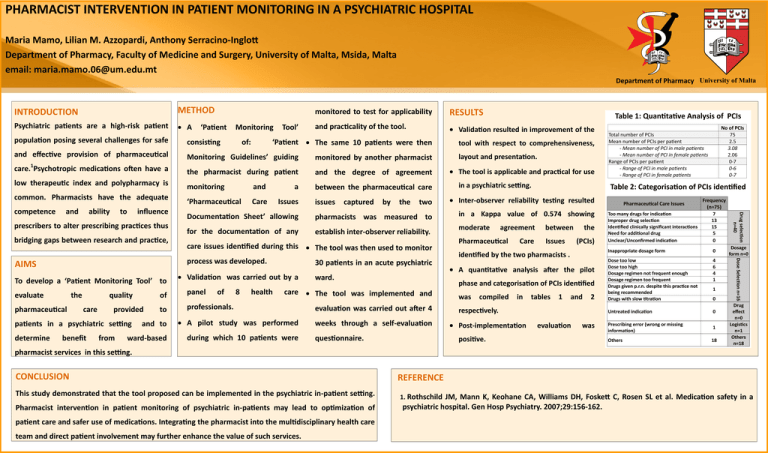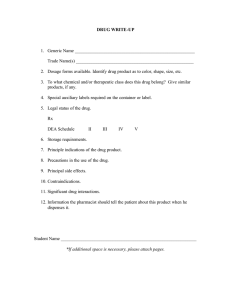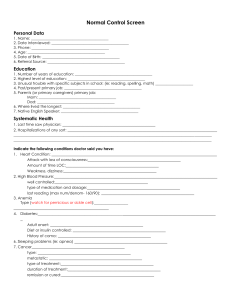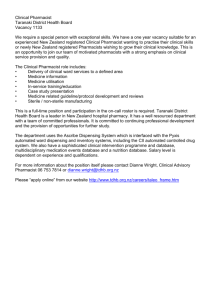PHARMACIST INTERVENTION IN PATIENT MONITORING IN A PSYCHIATRIC HOSPITAL
advertisement

DEPARTMENT OF PHARM ACY UNIVERSI TY OF MA LTA PHARMACIST INTERVENTION IN PATIENT MONITORING IN A PSYCHIATRIC HOSPITAL Maria Mamo, Lilian M. Azzopardi, Anthony Serracino-Inglott Department of Pharmacy, Faculty of Medicine and Surgery, University of Malta, Msida, Malta email: maria.mamo.06@um.edu.mt Department of Pharmacy University of Malta INTRODUCTION METHOD Psychiatric patients are a high-risk patient A ‘Patient Monitoring Tool’ monitored to test for applicability RESULTS and practicality of the tool. Validation resulted in improvement of the population posing several challenges for safe consisting and effective provision of pharmaceutical Monitoring Guidelines’ guiding monitored by another pharmacist care. Psychotropic medications often have a the pharmacist during patient and the degree of agreement low therapeutic index and polypharmacy is monitoring and a ‘Pharmaceutical Care Issues 1 common. Pharmacists have the adequate and ability to influence prescribers to alter prescribing practices thus bridging gaps between research and practice, for the documentation of any evaluate the pharmaceutical quality care provided from to of 8 health professionals. A pilot study was performed ward-based during which 10 patients were Table 2: Categorisation of PCIs identified pharmacists was measured to in a Kappa value of 0.574 showing captured by the establish inter-observer reliability. ward. moderate agreement Pharmaceutical Care between Issues the (PCIs) identified by the two pharmacists . A quantitative analysis after the pilot phase and categorisation of PCIs identified care The tool was implemented and and to patients in a psychiatric setting benefit of panel in a psychiatric setting. evaluation was carried out after 4 weeks through a self-evaluation questionnaire. was compiled in tables 1 and 2 respectively. Post-implementation Total number of PCIs Mean number of PCIs per patient - Mean number of PCI in male patients - Mean number of PCI in female patients Range of PCIs per patient - Range of PCI in male patients - Range of PCI in female patients evaluation was positive. Frequency Pharmaceutical Care Issues (n=75) Too many drugs for indication 7 Improper drug selection 13 Identified clinically significant interactions 15 Need for additional drug 5 Unclear/Unconfirmed indication 0 Inappropriate dosage form 0 Dose too low Dose too high Dosage regimen not frequent enough Dosage regimen too frequent Drugs given p.r.n. despite this practice not being recommended Drugs with slow titration 4 6 4 1 1 0 Untreated indication 0 Prescribing error (wrong or missing information) 1 Others 18 Dosage form n=0 Dose Selection n=16 To develop a ‘Patient Monitoring Tool’ to The tool is applicable and practical for use two issues 30 patients in an acute psychiatric Validation was carried out by a layout and presentation. Inter-observer reliability testing resulted care issues identified during this The tool was then used to monitor process was developed. AIMS determine Documentation Sheet’ allowing between the pharmaceutical care tool with respect to comprehensiveness, No of PCIs 75 2.5 3.08 2.06 0-7 0-6 0-7 Drug selection n=40 competence ‘Patient The same 10 patients were then of: Table 1: Quantitative Analysis of PCIs Drug effect n=0 Logistics n=1 Others n=18 pharmacist services in this setting. CONCLUSION This study demonstrated that the tool proposed can be implemented in the psychiatric in-patient setting. Pharmacist intervention in patient monitoring of psychiatric in-patients may lead to optimization of patient care and safer use of medications. Integrating the pharmacist into the multidisciplinary health care team and direct patient involvement may further enhance the value of such services. REFERENCE 1. Rothschild JM, Mann K, Keohane CA, Williams DH, Foskett C, Rosen SL et al. Medication safety in a psychiatric hospital. Gen Hosp Psychiatry. 2007;29:156-162.





